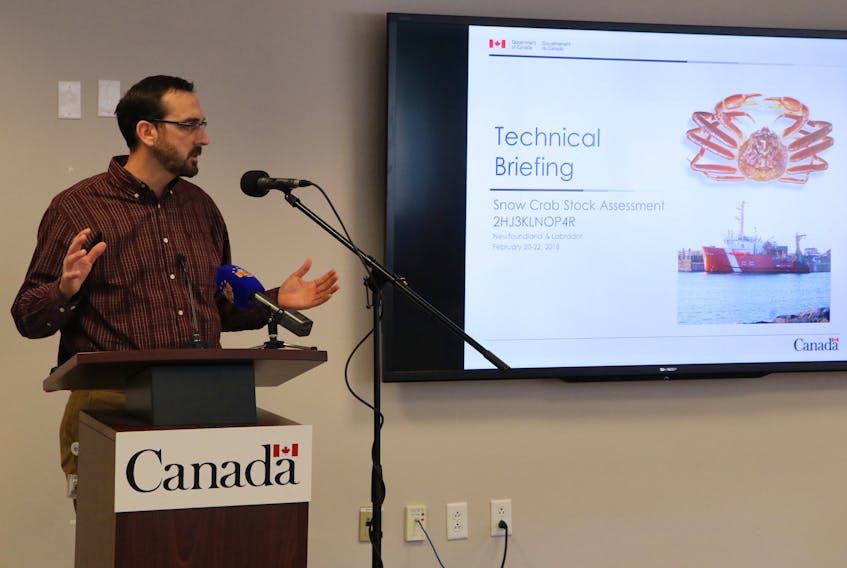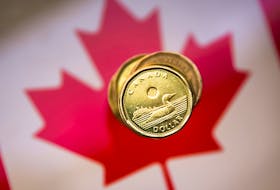Snow crab stocks off Newfoundland and Labrador remain at low levels going into this spring’s fishery, and while that may result in status quo or lower quotas, there is optimism for coming years.
The optimism may only hold true if measures are taken to further protect an apparent increase in small and medium-sized crab being seen in most areas of the province.
A technical briefing held by the Department of Fisheries and Oceans (DFO) Monday morning in St. John’s showed that while the snow crab biomass remains relatively unchanged from last year, more favourable water temperatures for crab have resulted in better production in the last couple of years.
Instead of what many predicted would be doom and gloom this spring in the crab fishery, scientist Darrell Mullowney revealed some hope for the stocks and, in turn, the fishery in future years.
“Trawl and trap surveys tell us that the overall exploitable biomass (the amount of crab of fishable size) has remained at its lowest observed level in the past two years,” Mullowney told members of the media. “Low exploitable biomass is concerning, as it could potentially elevate the impacts of fishing on present and future stocks.
“There appears to be more small and mid-sized crab in the water than we’ve seen for a few years, so looking beyond 2018 seems to be the most optimistic part of it. The message we are trying to relay this year is that we are concerned about low biomass allowing the pre-recruits — which will come in as soft-shell crab Year 1 into the fishery — to trap readily and be harvested, discarded and likely killed in the process. There is concern that what happens in 2018 could diminish any potential gains thereafter.”
Landings in the province’s snow crab fishery peaked at 53,500 tonnes in 2009 and gradually declined to 34,000 tonnes in 2017 — their lowest level in two decades.
This year’s total allowable catch (TAC) and any other management measures will be set by DFO following industry consultations throughout the province beginning on March 6, and consideration of scientific advice.
Mullowney noted the two main areas of concern in the province is off the east coast of the island in division 3L — particularly in waters around the Avalon Peninsula — and on the west coast.
In inshore 3L, he noted, the exploitable biomass index has declined 73 per cent since 2012, while overall recruitment has steadily declined for the past three years. Division 3L is where the majority of crab fishing activity takes place.
“Those are areas where it seems the harvest rates will be quite high in the forthcoming year without some management actions,” Mullowney said. “High fishing pressure may impact the fishery beyond 2018 if the recruits are captured as bycatch and discarded at a high level in 2018.”
Mullowney also noted that while warmer ocean temperatures a few years ago aided the rebuilding of groundfish stocks, a return to cooler ocean conditions in all snow crab divisions in recent years is positive for the snow crab stock. Snow crab do well in waters below 2 C, he noted.
“The warmest conditions were essentially during the 2010, 2011 and 2012 period that would have helped groundfish recover and conversely led to a decline in the productivity of the shellfish,” he said. “Since then, most years we’ve been above normal in terms of it being warm, but it hasn’t been to the extremes it was at that point.
“In previous years we didn’t have a lot of optimism because things were so warm that it just seemed an unproductive state for crab. The temperature is now back to kind of a normal level.”
The Fish, Food and Allied Workers (FFAW-Unifor) said Monday there were encouraging signs for the crab fishery in the technical briefing.
“Much of the information about future recruitment comes from the post-season crab pot survey conducted by FFAW members,” the FFAW stated in a news release. “The number of small mesh pots in the post-season survey have more than tripled, increasing the value of this survey as an index of incoming recruitment. FFAW is stressing that DFO have increased participation from harvesters in both science and management processes.”
The union said it is hopeful there will be no major cuts to the TAC for the upcoming season.
The release also noted that since 2014, the per-pound price for snow crab has increased by 88 per cent, from $2.34 per pound to $4.39.









